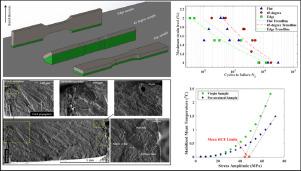当前位置:
X-MOL 学术
›
Int. J. Mech. Sci.
›
论文详情
Our official English website, www.x-mol.net, welcomes your feedback! (Note: you will need to create a separate account there.)
Toward low and high cycle fatigue behavior of SLM-fabricated NiTi: considering the effect of build orientation and employing a self-heating approach
International Journal of Mechanical Sciences ( IF 7.3 ) Pub Date : 2020-11-01 , DOI: 10.1016/j.ijmecsci.2020.105878 Parisa Bayati , Ahmadreza Jahadakbar , Mahmoud Barati , Mohammadreza Nematollahi , Luc Saint-Sulpice , Meysam Haghshenas , Shabnam Arbab Chirani , Mohammad J Mahtabi , Mohammad Elahinia
International Journal of Mechanical Sciences ( IF 7.3 ) Pub Date : 2020-11-01 , DOI: 10.1016/j.ijmecsci.2020.105878 Parisa Bayati , Ahmadreza Jahadakbar , Mahmoud Barati , Mohammadreza Nematollahi , Luc Saint-Sulpice , Meysam Haghshenas , Shabnam Arbab Chirani , Mohammad J Mahtabi , Mohammad Elahinia

|
Abstract Build orientation is one of the important parameters in the selective laser melting (SLM) process that could alter the mechanical and fatigue properties of the fabricated parts. In the first section of this paper, the monotonic tensile and low-cycle fatigue behavior of the SLM NiTi dog-bone samples fabricated in three different orientations are investigated. Based on the results, the highest fatigue life was for the samples fabricated in 45° with respect to the build plate, and the lowest fatigue life was for the samples fabricated on their edge. Furthermore, horizontally fabricated samples showed the highest scatter in fatigue life. It was revealed using SEM analysis that based on the build orientation, different types of defects, such as lack of fusion, entrapped gas porosities, and surface flaws could be generated inside the parts that could lead to a premature failure. In the second section of the paper, for the first time, the self-heating approach is utilized to investigate the high-cycle fatigue behavior of SLM NiTi samples fabricated in the horizontal direction. By considering the same origin for the fatigue damage and the one that generates the heat dissipation, self-heating approach can be used to predict the fatigue properties of the material. Using the self-heating approach, the fatigue limit for the virgin as well as pre-strained samples were evaluated. Similar to the conventional metals, the pre-strained sample showed a higher mean fatigue limit in comparison with the virgin samples.
中文翻译:

SLM 制造的 NiTi 的低周和高周疲劳行为:考虑构建方向的影响并采用自热方法
摘要 构建方向是选择性激光熔化 (SLM) 工艺中的重要参数之一,可以改变制造零件的机械和疲劳性能。在本文的第一部分,研究了在三个不同方向上制造的 SLM NiTi 狗骨样品的单调拉伸和低周疲劳行为。根据结果,相对于构建板以 45° 角制造的样品的疲劳寿命最高,而边缘制造的样品的疲劳寿命最低。此外,水平制造的样品在疲劳寿命方面表现出最高的分散性。使用 SEM 分析表明,基于构建方向,不同类型的缺陷,例如未熔合、夹带气体孔隙、零件内部可能会产生表面缺陷,从而导致过早失效。在论文的第二部分,首次利用自热方法研究了在水平方向上制造的 SLM NiTi 样品的高周疲劳行为。通过考虑疲劳损伤的同一起源和产生热耗散的起源,自热方法可用于预测材料的疲劳性能。使用自加热方法,评估了原始样品和预应变样品的疲劳极限。与传统金属类似,与原始样品相比,预应变样品显示出更高的平均疲劳极限。自加热方法用于研究在水平方向上制造的 SLM NiTi 样品的高周疲劳行为。通过考虑疲劳损伤的同一起源和产生热耗散的起源,自热方法可用于预测材料的疲劳性能。使用自加热方法,评估了原始样品和预应变样品的疲劳极限。与传统金属类似,与原始样品相比,预应变样品显示出更高的平均疲劳极限。自加热方法用于研究在水平方向上制造的 SLM NiTi 样品的高周疲劳行为。通过考虑疲劳损伤的同一起源和产生热耗散的起源,自热方法可用于预测材料的疲劳性能。使用自加热方法,评估了原始样品和预应变样品的疲劳极限。与传统金属类似,与原始样品相比,预应变样品显示出更高的平均疲劳极限。自热方法可用于预测材料的疲劳性能。使用自加热方法,评估了原始样品和预应变样品的疲劳极限。与传统金属类似,与原始样品相比,预应变样品显示出更高的平均疲劳极限。自热方法可用于预测材料的疲劳性能。使用自加热方法,评估了原始样品和预应变样品的疲劳极限。与传统金属类似,与原始样品相比,预应变样品显示出更高的平均疲劳极限。
更新日期:2020-11-01
中文翻译:

SLM 制造的 NiTi 的低周和高周疲劳行为:考虑构建方向的影响并采用自热方法
摘要 构建方向是选择性激光熔化 (SLM) 工艺中的重要参数之一,可以改变制造零件的机械和疲劳性能。在本文的第一部分,研究了在三个不同方向上制造的 SLM NiTi 狗骨样品的单调拉伸和低周疲劳行为。根据结果,相对于构建板以 45° 角制造的样品的疲劳寿命最高,而边缘制造的样品的疲劳寿命最低。此外,水平制造的样品在疲劳寿命方面表现出最高的分散性。使用 SEM 分析表明,基于构建方向,不同类型的缺陷,例如未熔合、夹带气体孔隙、零件内部可能会产生表面缺陷,从而导致过早失效。在论文的第二部分,首次利用自热方法研究了在水平方向上制造的 SLM NiTi 样品的高周疲劳行为。通过考虑疲劳损伤的同一起源和产生热耗散的起源,自热方法可用于预测材料的疲劳性能。使用自加热方法,评估了原始样品和预应变样品的疲劳极限。与传统金属类似,与原始样品相比,预应变样品显示出更高的平均疲劳极限。自加热方法用于研究在水平方向上制造的 SLM NiTi 样品的高周疲劳行为。通过考虑疲劳损伤的同一起源和产生热耗散的起源,自热方法可用于预测材料的疲劳性能。使用自加热方法,评估了原始样品和预应变样品的疲劳极限。与传统金属类似,与原始样品相比,预应变样品显示出更高的平均疲劳极限。自加热方法用于研究在水平方向上制造的 SLM NiTi 样品的高周疲劳行为。通过考虑疲劳损伤的同一起源和产生热耗散的起源,自热方法可用于预测材料的疲劳性能。使用自加热方法,评估了原始样品和预应变样品的疲劳极限。与传统金属类似,与原始样品相比,预应变样品显示出更高的平均疲劳极限。自热方法可用于预测材料的疲劳性能。使用自加热方法,评估了原始样品和预应变样品的疲劳极限。与传统金属类似,与原始样品相比,预应变样品显示出更高的平均疲劳极限。自热方法可用于预测材料的疲劳性能。使用自加热方法,评估了原始样品和预应变样品的疲劳极限。与传统金属类似,与原始样品相比,预应变样品显示出更高的平均疲劳极限。


























 京公网安备 11010802027423号
京公网安备 11010802027423号